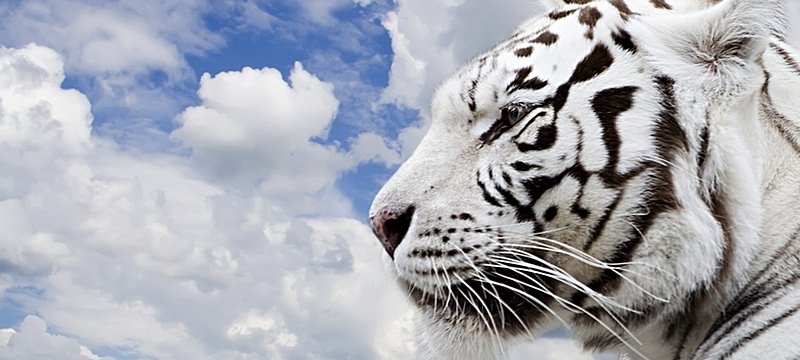One of the most popular felid is the domestic cat, that has being associated with humans about 10,000 years ago. However, the Felidae family include all other wild cats, including the “big cats”, a term commonly used to refer large wild cats.
The several species of cat are quite similar, in structure and behavior, despite of the enormous differences in size. All cats are carnivores and efficient apex predators.
What is it about the big cats that we find so attractive? They have something majestic! Their beauty, power, strength and athleticism resonates strongly with us. Everyone wants to see one in the wild!
Here is a list of the 10 largest felines! If you love this combination of power and beauty, prepare to see wonderful big cats!
10. Caracal (Caracal caracal)
Caracal is also known as the desert lynx and is found in Africa, Central Asia and Southwestern Asia. Males can weigh up to 42 pounds (19 kg). The trademark features of caracals are their elongated and black-tufted ears.
https://youtu.be/ghoifO8Azsg”
9. Clouded Leopard (Neofelis nebulosa)
The Clouded Leopard is found south of the Himalayas in Nepal, Bhutan, and some areas of northeastern India. Adults usually weigh between 40 and 51 pounds (18 to 23 kg).
The distinctive cloud-shaped markings of their coats make clouded leopards unmistakable. The fur is marked with elliptical blotches of a darker color than the background and the posterior edge of each blotch is partially framed in black.
https://youtu.be/5cGdTsMaCyI”
8. Eurasian Lynx (Lynx lynx)
Eurasian Lynx is the largest lynx species, and they can be found in a range extending from western Europe through the Russian boreal forests and to the Tibetan Plateau and Central Asia.
The adult male weighs from 40 to 79 pounds (18 to 36 kg). They are also one of the largest predators in Europe.
https://youtu.be/d5subqdPCxY”
7. Cheetah (Acinonyx jubatus)
The Cheetah is the world’s fastest land mammal, fast as 70 to 75 mph (112 to 120 km/h). The cheetah can accelerate from 0 to 60 mph (96 km/h) in three seconds! Most wild cheetahs are found in eastern and southwestern Africa. The adult cheetah weighs from 77 to 143 pounds (35 to 65 kg).
https://youtu.be/V8vejjVgIHg”
6. Leopard (Panthera pardus)
The Leopard can be found throughout Africa and Asia. Leopards are graceful and powerful big cats closely related to lions, tigers, and jaguars, and their average weight is 68 -143 pounds (31-65 kg).
Most leopards are light colored with distinctive dark spots that are called rosettes, because they resemble the shape of a rose. Black leopards, which appear to be almost solid in color because their spots are hard to distinguish, are commonly called black panthers. This development of the dark-colored pigment melanin in the skin is called melanism.
https://youtu.be/o-wdtGnefYk”
5. Snow leopard (Uncia uncia)
The Snow Leopard is native to the mountain ranges of Central and South Asia. Weighting up to 165 pounds (75 kg), snow leopard has a long thick fur, an adaptation to survive the cold mountains regions where they live and they use their thick furry tails like a blanket across their faces when they sleep, again to help them hold in heat.
https://youtu.be/EjxvrHDaxKc”
4. Cougar (Puma concolor)
The Cougar, also known as Puma, Mountain Cat, Mountain Lion or Panther, is the fourth largest species of Felidae, found from Southern Argentina and Chile to Southeastern Alaska. Adult males typically weigh 79 to 264 pounds (36-120 kg). Cougars are almost as large as jaguars, but are less muscular and not as powerful.
A curious fact: these slender agile cats hold the Guinness record for the animal with the highest number of names, including over 40 names in the English language alone!
https://youtu.be/feavfdrhBwc”
3. Jaguar (Panthera onca)
The Jaguar is the third largest species of Felidae, weighting up to 299 pounds (136 kg). Jaguar present range extends from Southwestern United States and Mexico across much of Central America and south to Paraguay and northern Argentina.
Melanism also occurs in the Jaguar. Black jaguars have the typical markings present, but are hidden by the excess black pigment melanin, giving an effect similar to that of printed silk.
https://youtu.be/KyGrDpBaPU0″
2. Lion (Panthera leo)
The Lion is the second largest living species of Felidae. Wild lions are currently found in sub-Saharan Africa and in Asia. Adult males typically weigh 416 pounds (189 kg); the heaviest male on record weighed 598 pounds (272 kg). Lions are the only members of the cat family to display obvious sexual dimorphism – that is, males and females look distinctly different.
https://youtu.be/16bvjHu-QbM”
1. Tiger (Panthera tigris)
And finally, the most powerful, heaviest and largest species of Felidae, the Tiger! While once spread throughout the entire continent of Asia and some of the outlying islands, it is now relegated to small areas of China, Russia, India, and Korea.
Siberian tigers, also know as Amur tigers (Panthera tigris altaica), are the largest among subspecies of tigers, which can weigh over 931 pounds (423 kg). Tigers are easily recognized by the rust-orange base coat and black stripes.
https://youtu.be/LcWyyyms07w”
Recently, the world’s largest living feline on Earth entered into the 2014 edition of the Guinness Word Records with the name Hercules. Hercules is a liger (a hybrid between a male lion and a tigress) who lives at the Myrtle Beach Safari wildlife preserve in South Carolina, with 131 in (3.3 m) long, measures 49 in (1.2 m) tall at the shoulder and weighs 922 pounds (418 kg)!
https://youtu.be/1zOWYj59BXI”
